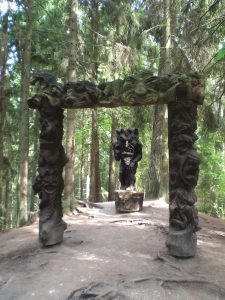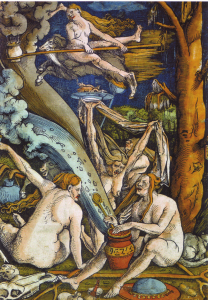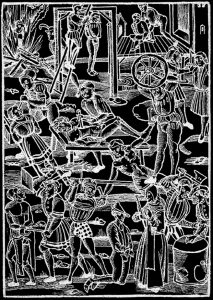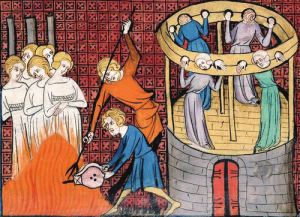By Miltiades Varvounis.
Witch hysteria took hold in Europe during the mid-1400s, when many accused witches confessed, often under torture, to a variety of wicked behaviors. Within a century, witch hunts were common and most of the accused were executed by burning at the stake or hanging.
The publication of Malleus Maleficarum – written by two well-respected Dominicans in 1487 – spurred witch mania to go viral. The infamous book, the title of which translates as The Hammer of Witches, was essentially a guide on how to identify, hunt and interrogate witches. Malleus Maleficarum labeled witchcraft as heresy, and quickly became the authority for Protestants and Catholics trying to flush out witches living among them. For more than 200 years, this book sold more copies of any other book in Europe except the Bible.
Therefore, it is no wonder that between the 14th and 17th centuries, more than 70,000 suspected witches were put to death in Europe. Around 80 percent of them were women thought to be in cahoots with the Devil and filled with lust. Germany had the highest witchcraft execution rate, while Ireland and the Grand Duchy of Lithuania (GDL) had the lowest.
Image of the Witch
The fiercest trials against witches took place in Germany, Spain, The Netherlands, Switzerland and France. Other European countries and the New World were not far behind. The GDL remained on the periphery of these dramatic events. The scale of witch hunts in the Lithuanian lands was much smaller, as was the number of executions. According to several sources, of the Lithuanian subjects accused of this crime, only every fifth suspect actually received the death sentence, although fewer than 15% were completely acquitted. In Northwestern Europe, the majority of the accused in such court procedures were women. Between the 1400s and the mid 1700s, the percentage of accused who were women was around 80% in Germany, and more than 90% in France and in Switzerland. Even in the neighboring Polish kingdom, this figure was almost 90%. Interestingly enough, in the GDL fewer than 60% of the total number of people accused of witchcraft were women. Most “witches” were aggressive or combative wives or widows of agricultural workers of low socioeconomic standing. But what was the image of the witch in the GDL, and did it differ greatly from the image in other countries?

The Lithuanian image of a witch (ragana in Lithuanian) was a combination of an archetypal goddess and a woman sorceress, and was associated with a person who had the potential to make prophecies. After the conversion of Lithuania to Christianity (1387), elements of the pagan way of seeing the world remained present in people’s consciousness for a very long time. Witchcraft was an important component of Lithuanian life in those early times and it was practiced by sorcerers and healers. Even Martynas Mažvydas’ Catechism (1547) mentioned village sorceresses that sick peasants would turn to for help, since most of Lithuanian villages didn’t have any doctors. These sorcerers would use charmed herbs to heal patients. Sources also highlight the fact that many Lithuanian peasants still appealed to and worshipped pagan gods, demons in the eyes of Christians, instead of the Church as late as the 17th century. The Church did not view this as heresy, but rather as superstition, the result of peasants’ lack of education. The Church’s response was not to require punishment, but to more fully spread the word of God and Christian morality, enlisting the help of the Jesuit Order to establish local missions. For instance, in late 16th century Bishop Eustachijus Valavičius (Eustachy Wołłowicz) considered sorcerers and witches to be lumped together with thieves, drunks, robbers and adulterers: “sorcerers, witches, thieves, drunks, robbers, adulterers and those who live together in sin but have not fulfilled the sacrament of matrimony, I order that they and none like them shall be found among my subjects: such people must be strictly punished, and driven from my city.”
When Piotr Skarga’s Žywoty Šwiėtych (Lives of the Saints) appeared in Vilnius in 1579, a great deal of attention was given to holy persons’ struggles against the Devil, against the possessed, demons, witches, devils and spells. The idea of believing in some persons’ abilities to communicate with the Devil and seek his help in order to harm others found its way into the GDL through Jesuit Skarga’s work. The clergy, especially the preaching orders, facilitated the spread of images of the Devil, demons and witches, and his collaborators, among the broader masses. As a result, during the 17th century, the image in Lithuanians’ consciousness of a witch-sorceress was gradually replaced by the image of witch as the Devil’s helper.
First accusations and procedures.
The earliest information we have about witchcraft trials in the GDL comes to us from the beginning of the Renaissance. A Latin poem by humanist Mikołaj Hussowczyk (Mikalojus Husovianas) written in 1523 called A Song about the Appearance, Savagery and Hunting of the Bison described Lithuania’s landscape and the elements of paganism that were widespread in these lands, as well as sorcery, the floating of a witch and her violent death through burning. However, the first written source that mentions the name of a witch comes from the notice of the palatine Ivan Bogdanovich Sapieha (Ivanas Bogdanovičius Sapiega) dated 5 August 1532, which concerned the rehabilitation of Maria Nesterovna, who had been accused of witchcraft and driven from the city and lands of Vitebsk (in present-day Belarus).

Interestingly enough, the first accusations of witchcraft in Lithuania were against herbalists and midwives of peasant background, regardless of the fact that the medieval religious literature acknowledged the possibility of having God’s gift of knowing about plants and herbs and their powerful properties. With their spells, these herbalists tried to heal someone or help during a birth, but it was not uncommon for them to be accused of witchcraft by other residents. For example, in 1552 a resident of Kaunas called Jadwiga was accused of teaching a spell to Elena of Kėdainiai so that she might have a normal birth without any
complications. In 1563, a herbalist from Kaunas called Kotryna was interrogated. She admitted that the Devil had helped her learn about herbs and how to use them for healing purposes. But she added that the herbs did not harm but helped ill people. Three years later, also in Kaunas, the witch Ulijona was accused as a witch and was burned in the square, allegedly for using herbs to poison people. In 1580, a man this time, herbalist Mateusz Junkiewicz (Motiejus Junkevičius) was interrogated regarding his knowledge and art.
The witchcraft trial procedure in the GDL consisted of several main parts: the accusation, serving a summons, interrogation, ordeal, imprisonment, merciless torture, passing of the verdict, and punishment. All of these stages took place only in castle courts. The procedure in cooperative and estate courts was usually much shorter and often more violent. However, an appeal was also possible. For example, in 1631, Jurijus Moras, the defender of witch Raina Gromykienė, who had received a death sentence at the Novahrudak (Naugardas) castle court, made an appeal to the Supreme Tribunal, and proved that the verdict was invalid, as it was not passed in accordance with the proscribed set of procedures, i.e. the court trial was held without an official summons.
Witchcraft ordeals
The main forms of evidence, according to Malleus Maleficarum, depended on how obviously the crime was manifested. Public threats, for example, were considered a form of evidence, as was the same kind of evidence from several witnesses, as well as the witch’s own confession. In Western Europe evidence would be collected by an inquisitor. But in the GDL, it was the plaintiff who had to procure court evidence to support his or her claim. Usually two or three witnesses in court were sufficient for this purpose.

One of the most common forms of obtaining evidence in witchcraft trials was a set of witchcraft ordeals, or tests. These were similar to the ‘Court of God’ (iudicia dei), or trial by ordeal in medieval times, where they were a form of strict punishment. The most popular ordeal involved water, or floating a witch. The point of this test was that water, as a source of cleanliness created by God, would be rejected by collaborators of the Devil, thus witches would not sink. In addition, it was believed that a witch who had powers given to her by the Devil would be lighter than other people and thus would not sink. The floating was always a public event, at which the whole village would gather. In Lithuania, the public would be not just observers, but participants as well. For example, on 15 May 1615, Sofija Jurgelienė, her son, and another peasant from the village of Magūnai northeast from Vilnius, were accused of witchcraft and had to undergo a water ordeal. The suspected were tied up and lowered into water one by one. They were each thrown into the water twice. They did not drown, and thus the village community acknowledged them as witches. Afterwards, the most morally upstanding person from among the villagers was selected, tied up and thrown into the water. Unlike the accused, he immediately sank to the bottom, and the crowd could only just revive him when they pulled him out. After such a spectacle, it was clear to everyone that the innocent drown. However, trying to prove that the accused was a witch by the water ordeal alone was not always enough. Sometimes the accused who had floated would be released on ground of insufficient evidence. The confirmation of witchcraft required an admission of guilt from the accused, or a public oath by the plaintiff and witnesses.
Tortures
During an interrogation, when there was obvious evidence, or the plaintiff had sworn that the accused was a witch, but the accused denied it, torture would be allowed. There were cases where torture continued even after a confession, in order to find out about any collaborators. Secular legal acts regulated torture in witchcraft cases in the GDL. Chapter 13 Article 14 of the First Statute of Lithuania (1529) stated that the accused could be tortured three times a day. However, if a confession was not elicited, the person who submitted the person to brutal torture had to compensate the accused: to pay half a ruble for each case of torture, i.e. around 50 groschen.

(Anonymous, 14th century, Wikipedia)
In witchcraft trials in the GDL, torture became more frequent from the second half of the 17th century, when judges were more persistent in trying to elicit a confession. The torture was often conducted in public. One day of spring in 1655, peasant Gertrūda Zaputkaitienė was tortured in the Raseiniai marketplace in the presence of many people, including nobles. She was tortured for hours with various instruments, and stretched three times. In 1680, at the Raulai estate in Samogitia, Zuzana Šleikienė was led out into the square. After a second round of interrogation, the accused was tortured without mercy three times.
Among the various methods for determining a potential witch’s guilt was the use of sleep deprivation. The accused would be traditionally starved of sleep for around 40 hours. Throughout, they would be interrogated and pressured to admit their identity as a servant of Satan. However, this method was generally seen as unreliable because people quickly became delirious enough to confess to anything.
The death sentence in the GDL was no different from that in the other kingdoms and duchies. Burning was the most common punishment in Europe and the New World, even though a specific punishment for witchcraft was not mentioned in the Statutes of Lithuania. Of the survived witch files, a majority (80%) of death sentences by burning were carried out in estate courts. The punishment ceremony was a public spectacle. The accusation would be read to the public at the place of burning, and the verdict would be carried out. Before the execution, the convicted could still retract their accusations against ‘collaborators’ they had betrayed. The death penalty did not always proceed smoothly. In the spring of 1680, in Samogitia, when a peasant, Saliamonas Puzas, was being burnt, observers were surprised that the bonfire would not burn, and that magpies were flying in circles above the unlucky victim.
“Hill of Witches”
How many of those accused of witchcraft died in the GDL throughout centuries? We know from the survived files between 1552 until the abolition of witchcraft as a capital crime in 1776, that at least 97 trials took place, in which 363 people were accused of witchcraft, resulting in 75 of them being executed. This was a small number compared with the 867 known trials under the Polish crown during the same time period.
Today, those who travel to Lithuania have a chance to visit the “Hill of Witches” (Lithuanian: Raganų Kalnas) – an outdoor sculpture gallery in the Lithuanian seaside resort of Juodkrantė. The pieces depict characters, mainly witches, devils and demons, from Lithuanian folklore and pagan traditions. To this day, every year on June 24th, people across Lithuania dance, sing and welcome the midsummer according to old folk traditions. After Christianity came to Lithuania, the celebration was renamed Saint John Festival, yet many of the practices have pagan roots, as echoed by the fantastic world depicted in the “Hill of Witches” sculptures.
 DRAUGAS NEWS Lithuanian World Wide News in English
DRAUGAS NEWS Lithuanian World Wide News in English
